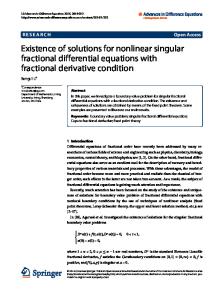Existence of fuzzy fractional stochastic differential system with impulses
- PDF / 456,675 Bytes
- 21 Pages / 439.37 x 666.142 pts Page_size
- 99 Downloads / 422 Views
Existence of fuzzy fractional stochastic differential system with impulses J. Priyadharsini1 · P. Balasubramaniam1 Received: 5 February 2020 / Revised: 4 June 2020 / Accepted: 13 June 2020 © SBMAC - Sociedade Brasileira de Matemática Aplicada e Computacional 2020
Abstract Stochastic differential equations represent equipment in modeling of a dynamic systems operating with fuzzy settings driven by stochastic noise. In this manuscript, a new kind of equation, namely fuzzy fractional stochastic differential system (FSDS) is proposed. It is defined by stochastic integral of a fuzzy process with respect to the m-dimensional Brownian motion. In this paper, the existence and uniqueness results are obtained for impulsive fuzzy FSDS with granular derivative using contraction principle. Finally, we provide a numerical example for the effectiveness of the theoretical results. Keywords Banach contraction · Fuzzy fractional · Fuzzy stochastic · Granular differentiability · Impulsive systems Mathematics Subject Classification 26A33 · 34A08 · 35K05 · 34A07 · 44A05 · 35R13 · 35R60
1 Introduction In 1965, Zadeh proposed a concept of fuzzy set theory (Zadeh 1965). Fuzzy differential equations (DEs) have studied by many researchers (Hoa et al. 2015; Kaleva 1987; Nieto et al. 2009). Balasubramaniam and Muralisankar (2004) have derived the existence and uniqueness of fuzzy integrodifferential equations with nonlocal conditions. The fuzzy stochastic DEs may be applicable in the investigation of various engineering and economic problems where the development are subjected to both randomness and fuzziness. Randomness dealt with the stochastic variability of all feasible outcomes of a situation whereas fuzziness relates to unsharp boundaries of the parameters of the model. Stochastic differential equations (SDEs) and fuzzy SDEs would be one of the best tools in the modeling of fuzzy random phenomena. Existence of random fuzzy DEs has been proved in Malinowski (2009, 2015) and Park
Communicated by Rosana Sueli da Motta Jafelice.
B 1
P. Balasubramaniam [email protected] Department of Mathematics, The Gandhigram Rural Institute, Deemed to be University, Gandhigram, 624 302 Dindigul, Tamil Nadu, India 0123456789().: V,-vol
123
195
Page 2 of 21
J. Priyadharsini, P. Balasubramaniam
and Jeong (2013). Malinowski (2015a) and Malinowski and Mitchta (2010) have derived the existence and uniqueness of the fuzzy stochastic differential/integral equations. In recent times, fractional differential equations (FDEs) are attracting more attentions because they are more efficient for modeling several real-world problems. FDEs seem to possess some drawbacks. One amongst them is that the initial value assigned to the model. More general, the determination of initial values is extremely difficult. It always involves uncertainty quantities, when dealing with real physical phenomena. To handle uncertainty quantities, many researchers implemented several new approaches. The one that stands out among the ideas is fuzzy set theory, see Zadeh (1965). This
Data Loading...











